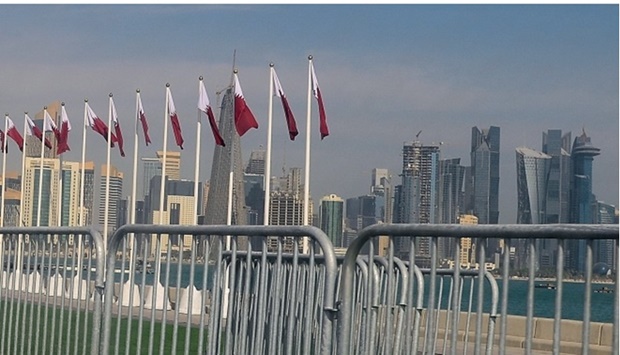Qatar’s merchandise trade balance, which denotes the difference between exports of goods and imports of goods, may scale up to $83.7bn in 2026, FocusEconomics has said in a report.
Merchandise trade balance this year will be $81.2bn and $79.6bn (in 2023), $77.6bn (2024) and $78.9bn (2025).
The current account balance, the researcher said will scale down to $27.9bn in 2026 from $41.3bn in 2022.
The country’s GDP, FocusEconomics noted, will reach $232bn in 2026 from $206bn this year. Next year, it is estimated to stay at $206bn, followed by $211bn (2024) and $222bn (2025).
Qatar’s public debt (as a percentage of the GDP) has been estimated to fall to 41.7 in 2026 from 46.4 in 2022. Next year, it is estimated at 42.4, and 43.6 (in 2024) and 42.6 (2025).
Fiscal balance (as a percentage of the GDP), FocusEconomics noted, will be 8.4 this year, followed by 5.7 (2023), 3.0 (2024), 3.6 (2025) and 4.2 (2026).
GDP per capita will scale up to $91,484 in 2026 from $77,154 this year. Next year, it will be $78,590, and $81,384 (2024) and $86,400 (2025).
After a mild overall GDP growth in Q4, 2021 driven by the non-energy sector, available indicators suggest a further solid non-energy performance in Q1, 2022, FocusEconomics said.
The private-sector PMI averaged well in expansionary territory in the quarter. March’s reading was strong in particular, driven by accelerated expansions in output and new orders.
Moreover, visitor arrivals soared in annual terms in January–February thanks to milder Covid-19 restrictions.
That said, the energy sector seemed to perform less well, as February saw a double-digit decline in oil and gas extraction output.
In April, Qatar and Saudi Arabia formed a joint business council, with a view to boosting trade ties.
“Qatar’s GDP growth should speed up this year due to improved private consumption, ongoing gas sector investment, warming relations with Gulf neighbours and the boost to tourism coming from the FIFA World Cup - scheduled for late 2022,” FocusEconomics said.
A reinstatement of restrictions due to new Covid-19 variants remains a key risk, as are higher consumer prices stemming from the war in Ukraine.
FocusEconomics panellists see a 4.3% rise in GDP in 2022, which is unchanged from last month’s forecast, and 2.7% growth in 2023.
Inflation rose to 4.4% in March from 4.0% in February. Price pressures are expected to be notably higher this year compared to last, on elevated global commodity prices and stronger domestic consumption.
FocusEconomics panellists see the country’s inflation averaging 4.0% in 2022, which is up 0.3 percentage points from last month’s forecast, and 2.5% in 2023.
Merchandise trade balance this year will be $81.2bn and $79.6bn (in 2023), $77.6bn (2024) and $78.9bn (2025).
The current account balance, the researcher said will scale down to $27.9bn in 2026 from $41.3bn in 2022.
The country’s GDP, FocusEconomics noted, will reach $232bn in 2026 from $206bn this year. Next year, it is estimated to stay at $206bn, followed by $211bn (2024) and $222bn (2025).
Qatar’s public debt (as a percentage of the GDP) has been estimated to fall to 41.7 in 2026 from 46.4 in 2022. Next year, it is estimated at 42.4, and 43.6 (in 2024) and 42.6 (2025).
Fiscal balance (as a percentage of the GDP), FocusEconomics noted, will be 8.4 this year, followed by 5.7 (2023), 3.0 (2024), 3.6 (2025) and 4.2 (2026).
GDP per capita will scale up to $91,484 in 2026 from $77,154 this year. Next year, it will be $78,590, and $81,384 (2024) and $86,400 (2025).
After a mild overall GDP growth in Q4, 2021 driven by the non-energy sector, available indicators suggest a further solid non-energy performance in Q1, 2022, FocusEconomics said.
The private-sector PMI averaged well in expansionary territory in the quarter. March’s reading was strong in particular, driven by accelerated expansions in output and new orders.
Moreover, visitor arrivals soared in annual terms in January–February thanks to milder Covid-19 restrictions.
That said, the energy sector seemed to perform less well, as February saw a double-digit decline in oil and gas extraction output.
In April, Qatar and Saudi Arabia formed a joint business council, with a view to boosting trade ties.
“Qatar’s GDP growth should speed up this year due to improved private consumption, ongoing gas sector investment, warming relations with Gulf neighbours and the boost to tourism coming from the FIFA World Cup - scheduled for late 2022,” FocusEconomics said.
A reinstatement of restrictions due to new Covid-19 variants remains a key risk, as are higher consumer prices stemming from the war in Ukraine.
FocusEconomics panellists see a 4.3% rise in GDP in 2022, which is unchanged from last month’s forecast, and 2.7% growth in 2023.
Inflation rose to 4.4% in March from 4.0% in February. Price pressures are expected to be notably higher this year compared to last, on elevated global commodity prices and stronger domestic consumption.
FocusEconomics panellists see the country’s inflation averaging 4.0% in 2022, which is up 0.3 percentage points from last month’s forecast, and 2.5% in 2023.


